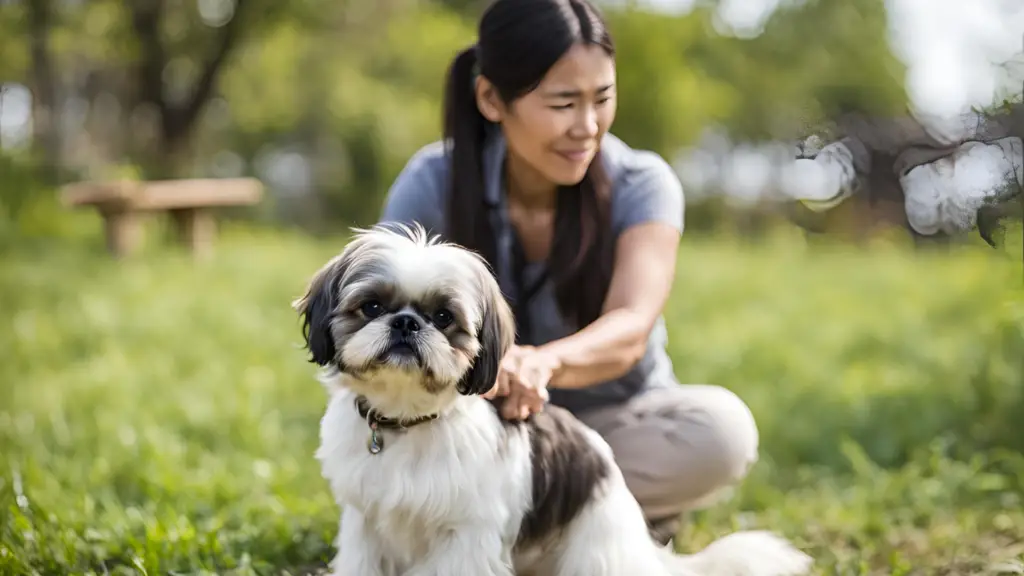
Training a Shih Tzu can be a rewarding experience that strengthens the bond between you and your furry friend. Known for their affectionate and friendly nature, Shih Tzus respond well to positive reinforcement and consistency. As a new owner, understanding the best training techniques is essential for ensuring your Shih Tzu grows into a well-behaved and happy companion. Here are the top five training tips for new Shih Tzu owners, each designed to help you navigate the training process effectively.
1. Start with Basic Commands
Starting with basic commands is crucial for establishing a foundation for more advanced training. Commands like “sit,” “stay,” “come,” and “down” are fundamental and should be introduced early in your Shih Tzu’s training. These commands not only help manage your dog’s behavior but also enhance their safety and your ability to communicate with them effectively.

Using positive reinforcement, such as treats, praise, and affection, is key when teaching these commands. Shih Tzus are eager to please and respond well to rewards. Consistency is important; practice the commands regularly and be patient. Keep training sessions short and fun to maintain your Shih Tzu’s interest and enthusiasm.
Teaching “Sit”
To teach your Shih Tzu to sit, hold a treat close to their nose and slowly move it up, allowing their head to follow the treat. Their bottom will naturally lower to the ground. Once they are in the sitting position, say “sit” and give them the treat along with praise. Repeat this several times daily until your Shih Tzu consistently sits on command.

Teaching “Stay”
Start by having your Shih Tzu sit. Hold your hand out in front of you, palm facing them, and say “stay.” Take a few steps back and if they stay, reward them with a treat and praise. Gradually increase the distance and duration they stay before giving the reward. Practice regularly to build their understanding and patience.
Teaching “Come”

Use a leash initially to teach the “come” command. Gently pull the leash towards you while saying “come” in an enthusiastic tone. When your Shih Tzu reaches you, reward them with a treat and praise. As they get better, practice off-leash in a safe, enclosed area.
Teaching “Down”
To teach “down,” hold a treat in your hand and slowly lower it to the ground. Your Shih Tzu will follow the treat with their nose and lie down. As soon as they lie down, say “down” and give them the treat. Practice this command regularly to reinforce the behavior.
2. Socialization is Key

Socialization is a critical aspect of training for Shih Tzus. Introducing your Shih Tzu to a variety of people, pets, and environments helps them become well-adjusted and confident. Proper socialization reduces the likelihood of fear and aggression in new situations and promotes positive interactions with others.
Begin socialization early by exposing your Shih Tzu to different experiences, such as meeting new people, encountering other dogs, and exploring various environments. Use positive reinforcement to reward calm and friendly behavior. Socialization should be a gradual process, allowing your Shih Tzu to become comfortable at their own pace.

Meeting New People
Introduce your Shih Tzu to different people, including adults and children. Encourage friends and family to interact with your dog in a positive and gentle manner. Reward your Shih Tzu for friendly behavior with treats and praise. Gradually increase the number of people your dog meets to build their comfort level.
Interacting with Other Dogs

Arrange playdates with other friendly dogs or take your Shih Tzu to a local dog park. Observe their interactions to ensure they are positive and intervene if necessary to prevent any negative experiences. Positive interactions with other dogs help your Shih Tzu develop good social skills and build confidence.
Exploring Different Environments
Expose your Shih Tzu to various environments, such as parks, streets, and busy areas. Gradually introduce them to different sounds, sights, and smells. Reward calm behavior and use positive reinforcement to build their confidence. Regularly exploring new environments helps your Shih Tzu adapt to different situations and reduces anxiety.
3. Consistent House Training

House training is one of the most important aspects of training for any new Shih Tzu owner. Consistency and patience are crucial for successful house training. Establishing a routine and using positive reinforcement will help your Shih Tzu understand where and when it is appropriate to relieve themselves.
Start house training by taking your Shih Tzu outside frequently, especially after meals, playtime, and naps. Use a designated spot for bathroom breaks and reward your dog with treats and praise when they go in the right place. Accidents are inevitable, so remain patient and avoid punishment.
Establishing a Routine

Create a consistent schedule for bathroom breaks, feeding times, and playtime. Taking your Shih Tzu outside at the same times each day helps them understand the routine and reduces accidents. Consistency is key to successful house training.
Using Positive Reinforcement
Reward your Shih Tzu immediately after they go to the bathroom in the appropriate spot. Use treats, praise, and affection to reinforce the behavior. Positive reinforcement encourages your dog to repeat the desired behavior.
Handling Accidents

If your Shih Tzu has an accident indoors, clean it up promptly and avoid scolding them. Punishment can create fear and confusion, hindering the house training process. Instead, reinforce the desired behavior by rewarding your dog when they go in the right place.
4. Crate Training for Safety and Comfort
Crate training is an effective way to provide your Shih Tzu with a safe and comfortable space. A crate can serve as a secure den where your dog can retreat for rest and relaxation. It is also a valuable tool for house training and preventing destructive behavior when you’re not home.

Introduce the crate gradually and make it a positive experience for your Shih Tzu. Use treats, toys, and praise to encourage your dog to enter and stay in the crate. Never use the crate as a form of punishment, as this can create negative associations.
Introducing the Crate
Place the crate in a quiet area of your home and leave the door open. Encourage your Shih Tzu to explore the crate by placing treats and toys inside. Allow them to enter and exit freely, creating a positive association with the crate.

Gradual Crate Training
Start by having your Shih Tzu spend short periods in the crate while you are at home. Gradually increase the time they spend in the crate, always using positive reinforcement. Once your dog is comfortable, you can begin leaving them in the crate for longer periods when you are away.

Creating a Comfortable Space
Make the crate comfortable with a soft bed, blankets, and toys. Ensure the crate is the right size, allowing your Shih Tzu to stand, turn around, and lie down comfortably. A cozy and inviting crate helps your dog feel secure and relaxed.
5. Addressing Behavioral Issues

Addressing behavioral issues promptly is essential for maintaining a well-behaved Shih Tzu. Common issues such as barking, chewing, and jumping can be managed with consistent training and positive reinforcement. Understanding the underlying causes of these behaviors is crucial for effective management.
Identify the triggers for unwanted behaviors and use training techniques to redirect your Shih Tzu’s attention. Providing mental and physical stimulation can help prevent boredom, which often leads to behavioral issues. Consistency and patience are key to resolving behavioral problems.

Managing Barking
Excessive barking can be a common issue in Shih Tzus. Determine the cause of the barking, whether it’s due to boredom, anxiety, or external stimuli. Use commands like “quiet” and reward calm behavior. Providing mental stimulation and regular exercise can also help reduce excessive barking.
Controlling Chewing

Chewing is a natural behavior for dogs but can become problematic if directed at inappropriate items. Provide your Shih Tzu with plenty of chew toys and redirect their attention if they start chewing on furniture or other items. Supervise your dog and use positive reinforcement to encourage appropriate chewing.
Preventing Jumping
Jumping on people can be a common behavior in Shih Tzus seeking attention. Teach your dog the “off” command and reward them when they keep all four paws on the ground. Consistently reinforce this behavior and ensure that all family members and visitors do the same.

Conclusion
Training your Shih Tzu requires patience, consistency, and a positive approach. Starting with basic commands, socialization, house training, crate training, and addressing behavioral issues are essential steps for new owners. By using positive reinforcement and understanding your Shih Tzu’s needs, you can build a strong bond and ensure they grow into a well-behaved and happy companion.
Remember that training is an ongoing process, and regular practice is key to maintaining good behavior. Each Shih Tzu is unique, so tailor your training methods to suit your dog’s personality and preferences. With dedication and the right techniques, you can enjoy a rewarding and fulfilling relationship with your Shih Tzu.


